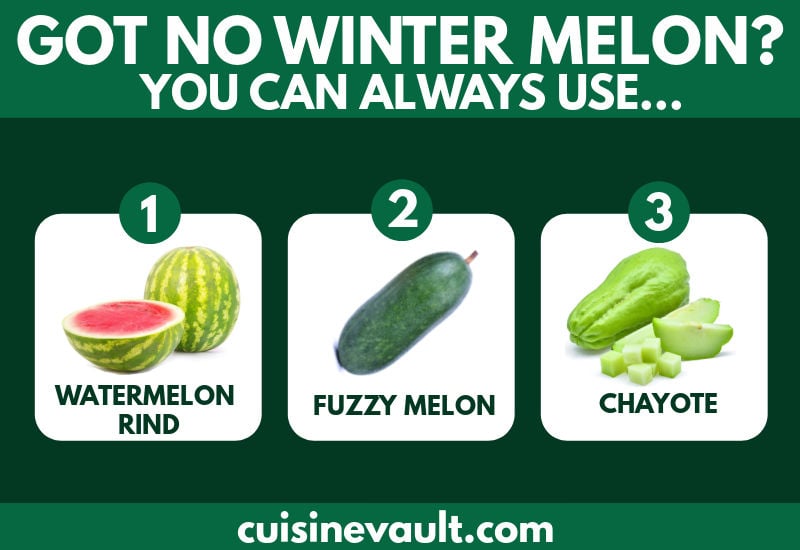Mature winter melons have a mild refreshing flavor with a subtle grassy undertone. People compare its taste to cucumber, although its texture is noticeably different. Rarely consumed raw, the cooked vegetable softens and becomes transparent. It is an excellent side dish for balancing out spicy food or heavy meat dishes.
If you don't have any winter melon in the kitchen and it's not available at your local supermarket then you're going to need a suitable replacement. We've compiled a list of excellent winter melon substitutes so that you can finish any recipe without the original ingredient.
What can I use to replace winter melon in cooking?
The best substitutes for winter melon are watermelon rind, fuzzy melon, or zucchini. They all share a similar mild, fresh flavor with a soft texture once cooked. Other options include chayote, cucuzza, bottle gourd, and bitter melon. Although they aren't a perfect match on flavor, they won't be out of place in the dish either. Use similar quantities of these replacements as you would winter melon.
1. Watermelon rind
People are often surprised to hear that watermelon rind is edible, as most eat the pink fruit and discard the rest. But once cooked, the white part of this melon is surprisingly similar in taste and texture. It can be used interchangeably with the winter melon in any recipe.
The benefit of using watermelon is that it is a common ingredient found in most parts of the world. You can buy a whole fruit then slice it in half and scoop out the flesh before storing it refrigerated. Next, use a peeler or paring knife to finely slice off the green skin. This can be discarded, leaving just the white pith which is now ready to cook.
2. Fuzzy Melon
The fuzzy melon makes an excellent substitute for winter melon. It looks a lot like a hairy zucchini and is much smaller than a winter melon. But they both have a similar mild flavor and can be used interchangeably in cooking. The fuzzy melon is perfect for stir-fries and soups; like the winter melon, it absorbs the taste from other ingredients.
3. Chayote
The chayote is also known as a mirliton or vegetable pear and is a variety of summer squash. Like most of the ingredients on this list, it is classified as a fruit but treated as a vegetable in cooking.
The chayote is a gourd that has a lumpy green appearance and thrives in warm climates. Its flavor is mild with a crunchy texture that softens once cooked. They can be used in soups and stews, or sliced finely and added raw to salads.
Finding fresh chayotes in the grocery store may be a challenge depending on where you live. In the United States, try a local farmers’ market or Whole Foods.
 4. Zucchini
4. Zucchini
In most parts of the world the zucchini, aka courgette, is an everyday ingredient. When grown at home they can reach a staggering size of almost one meter in length, but in stores, they are usually around 8 inches.
The zucchini has a mild flavor that is slightly bitter and sweet. Once cooked, it becomes tender and the sweetness shines through. It is an excellent replacement option for winter melon although its texture is mushier once cooked. Use zucchini in any recipe that calls for winter melon.
Related reading:
How do I freeze zucchini?
What are the differences between zucchini and cucumber?
5. Cucuzza
Cucuzza is a type of gourd which has white flesh, pale green skin and is shaped like a cucumber. In parts of South America, this summer vegetable is traditionally dried and used as a drinking gourd. It is also a delicious, firm-textured ingredient that is mild in flavor and ideal for stir-frying, sauteing, or adding to stews and soups.
If you use cucuzza to replace winter melon then avoid the mature ones as they turn bitter and aren't a close match to the ingredient you're trying to mimic.
6. Bottle Gourd
The bottle gourd is also known as a calabash and is an edible gourd that can be grown in a variety of shapes. It usually has a skin that ranges from pale to dark green and flesh that can be added to salads or cooked in casseroles and other hearty baked dishes.
Related reading: what does a calabash fruit taste like?
7. Bitter melon
If you're in a pinch, the bitter melon can be used in recipes that call for winter melon. It is considered one of the most bitter foods on the planet, so be warned! But there is a simple trick you can follow to help reduce this astringency. Cover the melon in salt and let it rest in a colander for 30 to 60 minutes before rinsing under the tap and using it in your next recipe.
Cooking the flesh will also help to tame the bitter flavor but nothing will completely remove the astringency. For those that enjoy a pungent bitter flavor in their food then this may be a better option than the winter melon.
Fast facts about winter melons
- They are also known as white gourd, wax gourd, ash pumpkin, Chinese winter melon, winter gourd, petha, dung gua, or jundol.
- The scientific name for winter melon is Benincasa hispida and it is part of the gourd family (Cucurbitaceae).
- The young melons have fine hairs that are fuzzy and look similar to snow. Some believe that this is where the name “winter melon” came from.
- They have a waxy skin once mature and can grow over a foot in length and 50 pounds in weight. They have white seeds and thick white flesh, like a watermelon’s rind.
- It is a popular ingredient used by manufacturers to make syrup for tea and candy.
- Chinese cuisine reveres the winter melon for adding freshness and balance to spicy, heavy food.
Related reading:
What does a luffa taste like?
What can I use as an okra substitute?
Summing up
The winter melon has a fairly bland taste, making it useful for taking on the flavor of other ingredients. It has a freshness that works well in dishes like Sichuan pork. If you don't have any for your next recipe then we recommend using watermelon rind, fuzzy melon, or zucchini. Of these three substitutes, watermelon rind will do the best job of mimicking the original ingredient. Only a seasoned chef will notice that you've done a sneaky swap. Fuzzy melon and zucchini, while having a slightly different taste and texture, are still excellent options and won't be out of place in any recipe that calls for winter melon.
Have you used winter melon in your cooking before? What is your favorite use for it in the kitchen? Please let us know in the comments below.

Leave a Reply